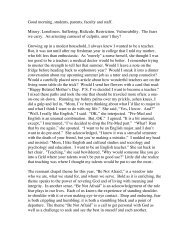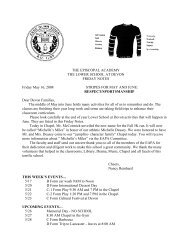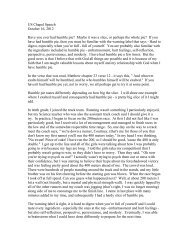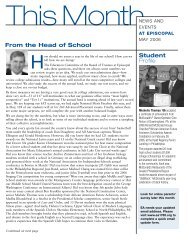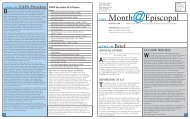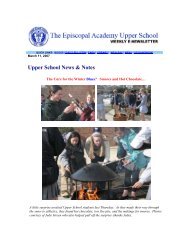The Birth of Team 2234 The Birth of Team 2234 - Episcopal Academy
The Birth of Team 2234 The Birth of Team 2234 - Episcopal Academy
The Birth of Team 2234 The Birth of Team 2234 - Episcopal Academy
Create successful ePaper yourself
Turn your PDF publications into a flip-book with our unique Google optimized e-Paper software.
scrim to complete and submit. A blind<br />
sampling was arranged (all entries were<br />
identified by number, not name) and the<br />
best entries were selected. Only those<br />
needleworkers who demonstrated proper<br />
techniques and a consistent stitching<br />
tension were asked to participate.<br />
Work Begins<br />
By February 1, 1979, the designs were<br />
drawn on the scrims and color-coded<br />
with numbers corresponding to wool<br />
yarns. Lisa Cox assembled all the materials<br />
at cost through her needlework<br />
store in Bryn Mawr. Gabby Haab <strong>of</strong>fered<br />
her guild-certified canvas-work<br />
expertise to prepare stitching instructions<br />
for the group. A copy <strong>of</strong> Gabby’s<br />
instructions that were dutifully typed<br />
up and distributed by Elaine Mastroi-<br />
Fisher Dixon Chapman<br />
cushion was sub-divided into two smaller<br />
sections (a rectangular piece and a<br />
corner piece); each one contained its own<br />
titled scene. As the sections were divided<br />
among the needleworkers, Carolyn<br />
Langfitt remembers she was “so disappointed<br />
when Flopsy Borda got to work<br />
the ‘Jesus Walking upon the Water’ section<br />
because I just loved that gorgeous<br />
red sail.” (Note: Carolyn’s ‘Flight into<br />
Egypt’ section turned out beautifully.)<br />
Stitching had to be similar and precise<br />
to have a unified appearance when<br />
the rectangular and corner sections<br />
were stitched together to make a single<br />
long cushion top. Every volunteer also<br />
worked the two-inch pale green needlepoint<br />
sides <strong>of</strong> the cushions, and “signed”<br />
her first, middle, and last name and<br />
“1980” in dark green stitching along<br />
<strong>The</strong> camaraderie among the committeewomen<br />
was strong. “We were all<br />
enthusiastic and single-minded about<br />
the project,” recalls Meredith Jones.<br />
Many met monthly to stitch, chart<br />
their progress, and to bolster each other’s<br />
spirits; the project was demanding<br />
and seemingly endless. One industrious<br />
committee member calculated that there<br />
are 146,608 stitches in each large kneeler<br />
averaging about 690 hours <strong>of</strong> work<br />
per kneeler.<br />
<strong>The</strong>re may have been some self-imposed<br />
pressure felt by those involved.<br />
As Kitty Blenko remembers: “Although<br />
it was not a race, you certainly didn’t<br />
want to be the last one to finish! It was<br />
a wonderful project, consumed our lives<br />
for two years but we all knew it would<br />
be a legacy that would remain with the<br />
A Piece <strong>of</strong> History<br />
<strong>The</strong> kneelers have been part <strong>of</strong> <strong>Episcopal</strong><br />
<strong>Academy</strong>’s history through several<br />
terms <strong>of</strong> leadership. Headmaster James<br />
McK. Quinn and Reverend James<br />
Trimble were involved in the project’s<br />
beginning. Head <strong>of</strong> School Jay Crawford<br />
and Chaplain Squire led the 1980<br />
dedication ceremony and witnessed<br />
their uninterrupted use in school activities,<br />
and current Head <strong>of</strong> School Ham<br />
Clark remarked: “We look forward to<br />
their continued presence at the Newtown<br />
Square campus. We are excited to<br />
move the best <strong>of</strong> our history with us and<br />
the kneelers are at the top <strong>of</strong> that list.”<br />
In fact, Bob Venturi and his architectural<br />
team were asked (and enthusiastically<br />
agreed) to rework the plans so that the<br />
communion cushions are employed<br />
Transportation to the New Campus<br />
<strong>The</strong> <strong>Episcopal</strong> <strong>Academy</strong> is committed to supporting the transportation needs <strong>of</strong> its students.<br />
Outlined below is our transportation plan for the 2008-2009 school year. As with any<br />
significant change, we know we may encounter situations we have not anticipated in our<br />
transportation planning. This will be a work in progress for the 2008-2009 school year as<br />
we all settle into new routines and a new location.<br />
Public School District Busing<br />
<strong>The</strong> following public school districts<br />
have confirmed they will transport<br />
students residing within their district<br />
to the Newtown Square campus:<br />
(Please contact the transportation<br />
1<br />
department <strong>of</strong> your local school<br />
district for details on hub locations<br />
and schedules)<br />
3<br />
R5<br />
Chester-Upland, Garnet Valley,<br />
Thorndale<br />
Dowingtown<br />
2<br />
Whitford<br />
Exton<br />
Great Valley, Haverford, Interboro,<br />
Malvern<br />
Paoli<br />
Daylesford<br />
Lower Merion, Marple Newtown,<br />
Berwyn<br />
Devon<br />
Strafford<br />
Wayne<br />
Methacton, Philadelphia,<br />
St. Davids<br />
Schuylkill River<br />
Radnor<br />
Phoenixville, Radnor, Ridley,<br />
Villanova<br />
Rosemont<br />
Bryn Mawr<br />
Rose Tree /Media, Southeast Delco,<br />
Haverford<br />
Ardmore<br />
Wynnewood<br />
Springfield Delaware County,<br />
Narberth<br />
Merion<br />
Tredyffrin/Easttown, Upper Darby,<br />
Overbrook<br />
Wallingford /Swarthmore,<br />
30th Street Suburban<br />
Station Station<br />
West Chester<br />
Transportation on SEPTA/Paoli Shuttle<br />
Shuttle service to the new campus from the Paoli SEPTA station will be provided in the<br />
morning and at regular intervals after school. Students should plan to board westbound or<br />
eastbound trains that will arrive in Paoli by 7:45 a.m. After school riders will be able to make<br />
departing trains at 4:00 p.m. and again at 6:00 and 6:30 p.m.<br />
<strong>The</strong> shuttle to and from the Paoli SEPTA train station is provided at no cost to families.<br />
Philadelphia Options<br />
Students residing in Philadelphia are encouraged to use the SEPTA R5 and the shuttle<br />
service described above . Using monthly, unlimited-use passes, students can ride from<br />
Center City to Paoli for $90 a month or $810 a year. Families wishing to use SEPTA, and that<br />
qualify for financial assistance, will have the monthly train pass costs factored into their aid<br />
package.<br />
For younger students and those not choosing to ride the train, <strong>Episcopal</strong> will make available<br />
a daily shuttle service from a hub in Society Hill and another hub in West Philadelphia. Pick<br />
up in Society Hill will be @ 6:45 a.m. and pick up in West Philadelphia will be @ 7:00 a.m.<br />
<strong>The</strong> shuttle will return to the same hubs in the afternoon @ 4:45 p.m. in West Philadelphia<br />
and @ 5:15 p.m. in Society Hill. If there is interest from Upper School students for a later<br />
return shuttle, we will add a run that departs Newtown Square at 6:10 p.m. We will add<br />
vehicles, as necessary, to this route as families commit to the service.<br />
We are in the process <strong>of</strong> securing hub locations that <strong>of</strong>fer easy access for parents, safety for<br />
children waiting, as well as shelter for bad weather. <strong>The</strong> cost for this service will be $2,850<br />
per student for the 2008-2009 school year. Families wishing to use this service, and that<br />
qualify for financial assistance, will have the shuttle costs factored into their aid package.<br />
Transportation by Car<br />
<strong>The</strong> new campus will feature a Lower School drop-<strong>of</strong>f area and a drop-<strong>of</strong>f location for<br />
all other students. Student drivers in V Form and VI Form will be given assigned parking<br />
spaces. We will be able to accommodate parking for all student drivers.<br />
anni still exists and includes guidelines<br />
such as, “<strong>The</strong> center is on horizontal<br />
lines #10 thru 15 (inclusive) with nine<br />
above and nine below” and “Use 18"<br />
lengths <strong>of</strong> yarn. To decrease twisting:<br />
Separate all <strong>of</strong> the triple strands into single<br />
strands before starting. Pull out two<br />
strands from the pile and check to see<br />
that you do not have two thicks or two<br />
thins. Check strands to see they each<br />
turn in opposite directions.”<br />
With this much attention to detail,<br />
there is a specialized language and technique<br />
that the untrained needleworker<br />
might not appreciate.<br />
All cushions contained side edges with<br />
45-degree angles so that when two such<br />
edges were aligned they would effectively<br />
‘turn’ the corners on the altar. Every<br />
Meredith Jones<br />
the back <strong>of</strong> her cushion. <strong>The</strong> pieced needlework<br />
was sewn together, edged with<br />
green piping, and backed with an unbleached<br />
linen. A long zipper down the<br />
center <strong>of</strong> the linen backing allows access<br />
to the pillow form inside.<br />
<strong>The</strong> project was so successful that<br />
even before the communion kneelers<br />
were completed, it was decided to create<br />
five smaller needlepoint kneelers for the<br />
altar steps (each highlights a single flower<br />
found within the large communion<br />
cushions), a seat cushion for both the<br />
Bishop’s chair and the Chaplain’s chair,<br />
and two seat cushions for the benches<br />
near the pulpit. <strong>The</strong> seating cushions<br />
contain a beautiful geometric pattern<br />
that, through a combination <strong>of</strong> stitches<br />
and shading, creates an optical illusion<br />
<strong>of</strong> rows <strong>of</strong> parallel stairways.<br />
school long after our children graduated.”<br />
<strong>The</strong> Mothers Association gave the<br />
completed set <strong>of</strong> needlepoint cushions<br />
to the school in May 1980 and, as Lois<br />
Susskind Muscheck recalls, “they were<br />
dedicated as part <strong>of</strong> a special chapel<br />
service.”<br />
Twenty-six years later, the needlepoint<br />
cushions are an integral part <strong>of</strong><br />
all services performed in the Chapel.<br />
<strong>The</strong> EAPA’s Altar Guild has assumed<br />
the responsibility <strong>of</strong> their care. At the<br />
end <strong>of</strong> every academic year, the cushions<br />
are removed from their positions in the<br />
sanctuary, wrapped in cotton sheeting,<br />
and placed in the sacristy’s drawers to<br />
protect them over the summer months.<br />
Every fall, they are back in place for the<br />
school’s opening chapel service.<br />
Jane Thompson<br />
as kneelers in the new chapel. <strong>The</strong><br />
smaller kneelers, the Chaplain’s and<br />
Bishop’s chairs, and the benches and their<br />
cushions will also find a home in the<br />
new chapel.<br />
<strong>The</strong> needlepoint kneelers are an<br />
important part <strong>of</strong> <strong>Episcopal</strong> <strong>Academy</strong><br />
history and will help create a bridge<br />
between the Merion and Newtown<br />
campuses. n<br />
6 Connections spring 2007 7



